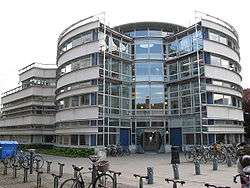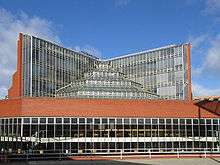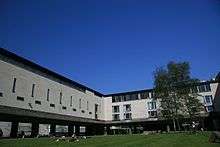Sidgwick Site
The Sidgwick Site is one of the largest sites within the University of Cambridge, England.[1][2]

Overview and history

The Sidgwick Site is located on the western side of Cambridge city centre, near the College backs. The site is north of Sidgwick Avenue and south of West Road, and is home to several of the university's arts and humanities faculties. The site is named after the philosopher Henry Sidgwick, who studied at Cambridge in the 19th century.[3] The site as it is now has its origins in plans drawn up by Casson and Conder in 1952 for making use of land to the west of the Cambridge city centre which was previously used mainly for sports. Much of the site's current architecture derives from these original plans. However, many faculty buildings, especially to the north of the site, have been designed by separate architects with little reference to the coherence of the site as a whole. In July 2002, the old Faculty of English, a converted Victorian villa, was demolished, and a more practical building designed by Allies and Morrison to reflect the needs of the faculty was completed in 2004. The Alison Richard Building, completed in 2012 and designed by Nicholas Hare Architects, brings together a number of different research groups (Interdisciplinary Geographical Centres), the new department of Politics and International Studies (POLIS) and the Centre for Research in Arts, Social Sciences and Humanities (CRASSH).

On 29 October 2006, Education Not For Sale supporters at Cambridge University organised the first occupation in the UK in protest at the introduction of top-up fees on the Sidgwick Site Lecture Hall, occupying it for 12 hours. In 2009, Cambridge Gaza Solidarity occupied three lecture theatres and the common area of the Law Faculty.[4]
Although less popular now, the site was formerly a thriving location with the local skateboarding community because of its undercover benches, numerous sets of stairs and L-shaped concrete banks. These features have since been amended to discourage skateboarding.[5]
Faculties on the Sidgwick Site

The following University of Cambridge faculties and departments are located on the site:[6]
- Faculty of Asian and Middle Eastern Studies
- Faculty of Classics with the Museum of Classical Archaeology
- Faculty of English, incorporating the Anglo-Saxon, Norse and Celtic
- Faculty of Music
- Faculty of History
- Faculty of Law
- Department of Politics and International Studies
- Faculty of Modern & Medieval Languages
- Faculty of Economics
- Faculty of Divinity
- Faculty of Philosophy
- Institute of Criminology
- Centre of Latin American Studies
The Department of Land Economy is planned to move to the Sidgwick Site.
Facilities
The site has a buttery which sells snacks and drinks throughout the day with seating inside and a number of picnic tables outside. There is also an Origin8 which offers a soup of the day, hot panini and wraps, sandwiches, snacks, and various drinks, and a number of food and drink machines along with seating in basement of the Law faculty building. The Modern & Medieval Languages faculty has tea/coffee machines on all floors and a snack machine.
There is a student prayer room on the Sidgwick Site located at the back of Lecture Block A. Here, the University Islamic Society holds Jamaat five times a day.
See also
- Lady Mitchell Hall, a large lecture theatre on the site
References
- University of Cambridge Official Map — Sidgwick Site Archived 1 May 2007 at the Wayback Machine, Cam.ac.uk
- Access map of Sidgwick Site, University of Cambridge, UK.
- "Sidgwick, Henry. Admm. pens. (age 17) at TRINITY, Apr. 14, 1855. [3rd] s. of [the Rev.] William (1823), of Rugby (and Mary Crofts)". A Cambridge Alumni Database. University of Cambridge. Retrieved 21 July 2017.
- , Cambridge News, 25 January 2009.
- "Archived copy". Archived from the original on 2 December 2013. Retrieved 18 July 2013.CS1 maint: archived copy as title (link)
- "AccessAble - Your Accessibility Guide". AccessAble - Your Accessibility Guide. Retrieved 25 March 2020.